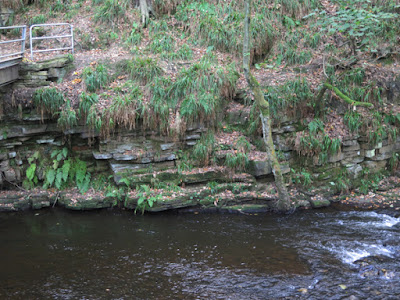 |
| A view to the north across Holme Bridge |
In the hour and a half that I spent exploring the village of Ashford-in-the-Water and Holy Trinity church, I encountered many building and decorative stones that I knew would be of interest to the Sheffield U3A Geology Group, and thought that the industrial archaeology in the area deserved further investigation.
 |
| An eastward view of the River Wye from the A6020 |
When I entered the village by the A6020, I had been surprised to see that the River Wye was divided into two branches and – when looking at a map of the stretch of the river between here and Bakewell – it looks like it has been diverted in several places, as I had recently seen all along the Loxley Valley in Sheffield.
 |
| A view of the Bowland Shale Formation along the River Wye |
Arriving back at the A6, to catch my bus back to Bakewell, I discovered that I had misinterpreted the bus timetable that I collected from Bakewell Visitor Centre earlier in the day, and that I would have to wait 30 minutes for the next bus. A passer-by noticed my dilemma and, after a short conversation in which the distance to Bakewell was briefly discussed, I decided to head off on foot – following the River Wye as far as I could.
 |
| A weir on the Ashford Hall Estate |
To the east of Ashford-in-the-Water, the river passes into a lake, with a small weir, which is overlooked by what appear to be non-native trees that I assume to be part of the old Ashford Hall Estate belonging to Lord George Cavendish and which was landscaped by Joseph Pickford.
 |
| A dry valley cutting into the Monsal Dale Limestone Formation |
After passing across a dry valley that once formed a tributary to the River Wye, and which cuts through the Eyam Limestone Formation into the underlying Monsal Dale Limestone Formation, the path leaves the course of the river and joins the A6 just to the west of Lumford Mill, one of three cotton mills built by Richard Arkwright.
 |
| A view of Lumford Mill from the A6 |
Continuing towards Bakewell, the roadside cutting on the south side of the A6 was largely obscured with thick vegetation, with only glimpses of the bedrock behind it, but there is a short stretch where bedded Monsal Dale Limestone – with a moderately steep apparent dip – forms a vertical rock face that immediately fronts the road.
 |
| An exposure of the Monsal Dale Limestone Formation on the A6 |
Unfortunately there is no path along this stretch of the road allows further exploration of this exposure of rock, which is in very close proximity to an outcrop of the Conksbury Bridge Lava Member – as marked on the British Geological Survey map – and it would be interesting to see if this volcanic rock is visible when the vegetation has died back over the winter period.
 |
| A general view of Holme Bridge |
On the outskirts of Bakewell, the A6 and the River Wye converge at Holme Bridge, built for pack horses, dated 1664 but, unlike the one previously seen in Ashford-in-the-Water, it is made of large, well squared blocks of gritstone - with cutwaters.
Entering Bakewell, a variety of listed buildings line both sides of Buxton Road, including an old mill, a Victorian church, Georgian townhouses and modest cottages and, although some have Carboniferous Limestone walling, most of the buildings are constructed of Millstone Grit.
 |
| A view of Buxton Road with various buildings constructed in Millstone Grit |
Generally, Millstone Grit is considered to be a durable building stone suitable for use in building elements exposed to extremes of wet and cold - often encountered in the Peak District - but in the mixed use building opposite the Catholic Church of the English Martyrs, the lower section of stonework has suffered from advanced weathering and decay, with the complete section of a house being completely renewed.
 |
| Restoration of Millstone Grit that has been damaged by road salt |
Arriving back in Bakewell just after 5 pm, in just two and a half hours I had encountered very many points of interest relating to geology, geomorphology, archaeology, industrial history, architecture, art and sculpture that I think would form the basis of a good field trip.
By now, after a very full day during which I had not stopped, I had decided that I was in no hurry to get back to Sheffield and, taking advantage of the Red Lion - a C17 coaching inn that is conveniently sited opposite the bus stop - I reviewed my day over a pint of Bakewell Best Bitter.
 |
| The Red Lion in Bakewell |













































